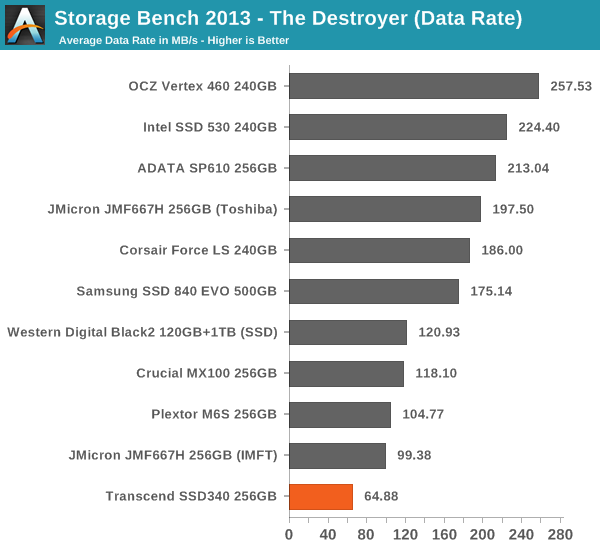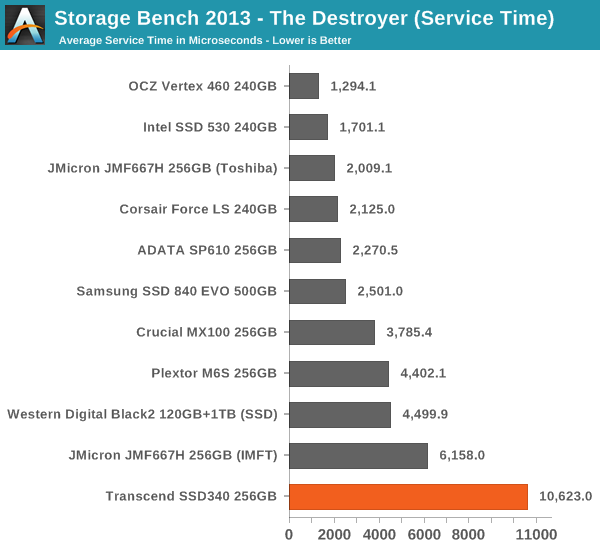Transcend SSD340 (256GB) Review
by Kristian Vättö on August 4, 2014 5:00 AM ESTAnandTech Storage Bench 2013
Our Storage Bench 2013 focuses on worst-case multitasking and IO consistency. Similar to our earlier Storage Benches, the test is still application trace based – we record all IO requests made to a test system and play them back on the drive we are testing and run statistical analysis on the drive's responses. There are 49.8 million IO operations in total with 1583.0GB of reads and 875.6GB of writes. I'm not including the full description of the test for better readability, so make sure to read our Storage Bench 2013 introduction for the full details.
| AnandTech Storage Bench 2013 - The Destroyer | ||
| Workload | Description | Applications Used |
| Photo Sync/Editing | Import images, edit, export | Adobe Photoshop CS6, Adobe Lightroom 4, Dropbox |
| Gaming | Download/install games, play games | Steam, Deus Ex, Skyrim, Starcraft 2, BioShock Infinite |
| Virtualization | Run/manage VM, use general apps inside VM | VirtualBox |
| General Productivity | Browse the web, manage local email, copy files, encrypt/decrypt files, backup system, download content, virus/malware scan | Chrome, IE10, Outlook, Windows 8, AxCrypt, uTorrent, AdAware |
| Video Playback | Copy and watch movies | Windows 8 |
| Application Development | Compile projects, check out code, download code samples | Visual Studio 2012 |
We are reporting two primary metrics with the Destroyer: average data rate in MB/s and average service time in microseconds. The former gives you an idea of the throughput of the drive during the time that it was running the test workload. This can be a very good indication of overall performance. What average data rate doesn't do a good job of is taking into account response time of very bursty (read: high queue depth) IO. By reporting average service time we heavily weigh latency for queued IOs. You'll note that this is a metric we have been reporting in our enterprise benchmarks for a while now. With the client tests maturing, the time was right for a little convergence.

Ouch, this is bad. The SSD340 is the slowest SSD in our 2013 Storage Bench and the difference is quite substantial. Given the results on the previous page along with the results here, it is clear that the SSD340 is not suitable for IO heavy workloads that require consistency. It still might have something to offer in lighter workloads, but that's looking increasingly doubtful.











57 Comments
View All Comments
TonyCL6 - Wednesday, August 6, 2014 - link
SSD370 should be pretty much the same as AData SP610 because of the controller and NAND configuration.Per Hansson - Monday, August 4, 2014 - link
The more things change the more they stay the same seems a fitting quote for this Transcend's SSD endeavors!homerdog - Monday, August 4, 2014 - link
Unless these drives fall way down the price ladder, there simply no reason for them to exist.MadMan007 - Monday, August 4, 2014 - link
Is there any budget SSD that makes sense in a world where the MX100 exists?Samus - Monday, August 4, 2014 - link
This drive (and this company) is completely irrelevant. I don't get why anybody would buy a drive outside of the Crucial/Micron/Intel/Samsung/Toshiba/Sandisk circle.Kingston, ADATA, Transcend, OWC, Mushkin, Corsair, and so on, make no compelling products and can't compete with Sandisk/Crucial on price because they don't make their own memory, controllers, or both.
hojnikb - Tuesday, August 5, 2014 - link
Pretty much. Unless you're owning a fab it's pretty hard to compete price wise.TonyCL6 - Wednesday, August 6, 2014 - link
Frankly for consumer market, only Samsung and maybe Toshiba has its own SSD controllers. The rest are now mainly using Marvell solutions. Kingston, ADATA, Transcend, OWC, Mushkin, Corsair and so on help Micron(Intel) and Toshiba(Sandisk) a lot to support/ consume their NAND Flash capacity. If they all gone, I personally don't think that would do any good to end-users. You can easily tell from how Samsung sells TLC and VNAND products. The cost of NAND is way much cheaper but that never reflects on the selling price.l_d_allan - Tuesday, August 5, 2014 - link
As Butch Cassidy said, "Don't sugar-coat it" :-)StrangerGuy - Tuesday, August 5, 2014 - link
Anandtech should just probably come blunt and say "If you can't beat the MX100 in price/performance/reliability don't even THINK about selling consumer SSDs thank you very much"Readers that visit this site ain't fooled no matter how much ads or exposure that comes down our throats.
hojnikb - Tuesday, August 5, 2014 - link
But its true. Why buy a turd, if you can speds a few extra bucks and get a proper drive.